Sheriff Mary D Fragonard Art and Eroticism Diana Endymion
Jean-Honoré Fragonard,The Swing, 1767, oil on sheet (Wallace Collection, London); speakers: Dr. Beth Harris and Dr. Steven Zucker
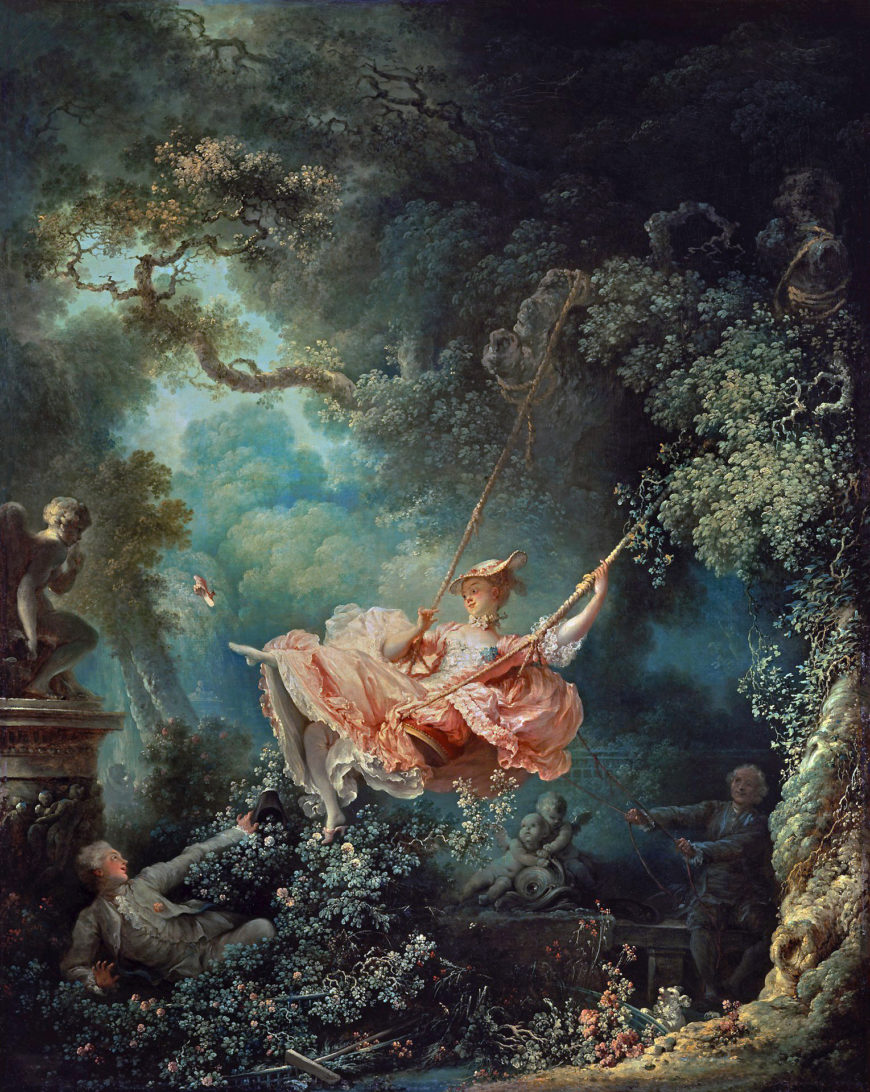
Jean-Honoré Fragonard, The Swing, oil on canvas, 1767 (Wallace Collection, London)
Inside a lush garden, a young adult female in a billowing pink gown glides through the air. Her suspension loftier in a higher place the ground is enabled by a swing consisting of a crimson velvet cushioned seat and a pair of ropes tied around the knobby branches of an enormous tree. On the far right, an older man seated on a stone bench helps operate the device. Using a serial of connected ropes, he pulls the swing dorsum to create the momentum necessary to propel the woman forward. As he releases the ropes, she leans back and extends her legs, expelling a tiny pink slipper from her pointed foot. The dainty shoe flies through the air toward a marble statue on the far left. At the base of the big pedestal supporting this sculpture lies a young man. Partially hidden past an overgrown rose bush-league, he peers wide-eyed up the open skirt of the swinging woman.
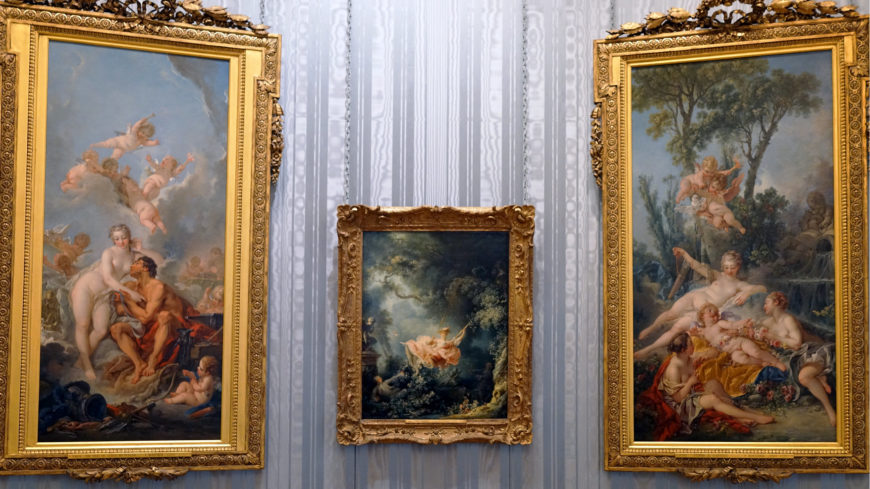
Jean-Honoré Fragonard, The Swing, 1767, oil on canvas (Wallace Drove, London, photo: Steven Zucker, CC BY-NC-SA ii.0)
This oil painting known equally The Swing was created by the French artist Jean-Honoré Fragonard sometime during 1767 and 1768. A admirer of the court reportedly requested the painter stand for his mistress being pushed on a swing every bit he secretly admired her from below. While the figures in the piece of work are not identifiable as portraits of specific individuals, their rich attire and leisurely activeness underline their aristocratic status.
Such playful and erotic scenes were popular among the elite clientele Fragonard served. Dissimilar large-scale history paintings, or the widely collected genres of portraiture and mural, these works were relatively pocket-sized (81 x 64.ii cm in the case of The Swing ) and intended for brandish in intimate rooms known as cabinets . Admiring the painting in the privacy of such a space, the patron and his inner circle would accept appreciated its depiction of societal norms subverted for the pursuit of personal pleasure. The work's strong appeal led to the product of a printed version by Nicolas Delaunay in 1782, which circulated among a broader, though even so elite, audience of collectors.
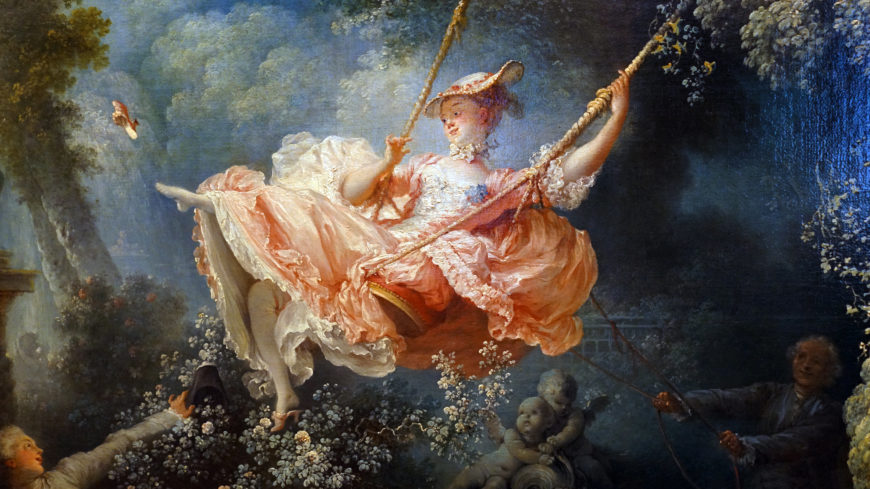
Female person figure (detail), Jean-Honoré Fragonard, The Swing, 1767, oil on sail, 81 x 64.ii cm (Wallace Collection, London; photo: Steven Zucker, CC BY-NC-SA ii.0)
Play and pleasure
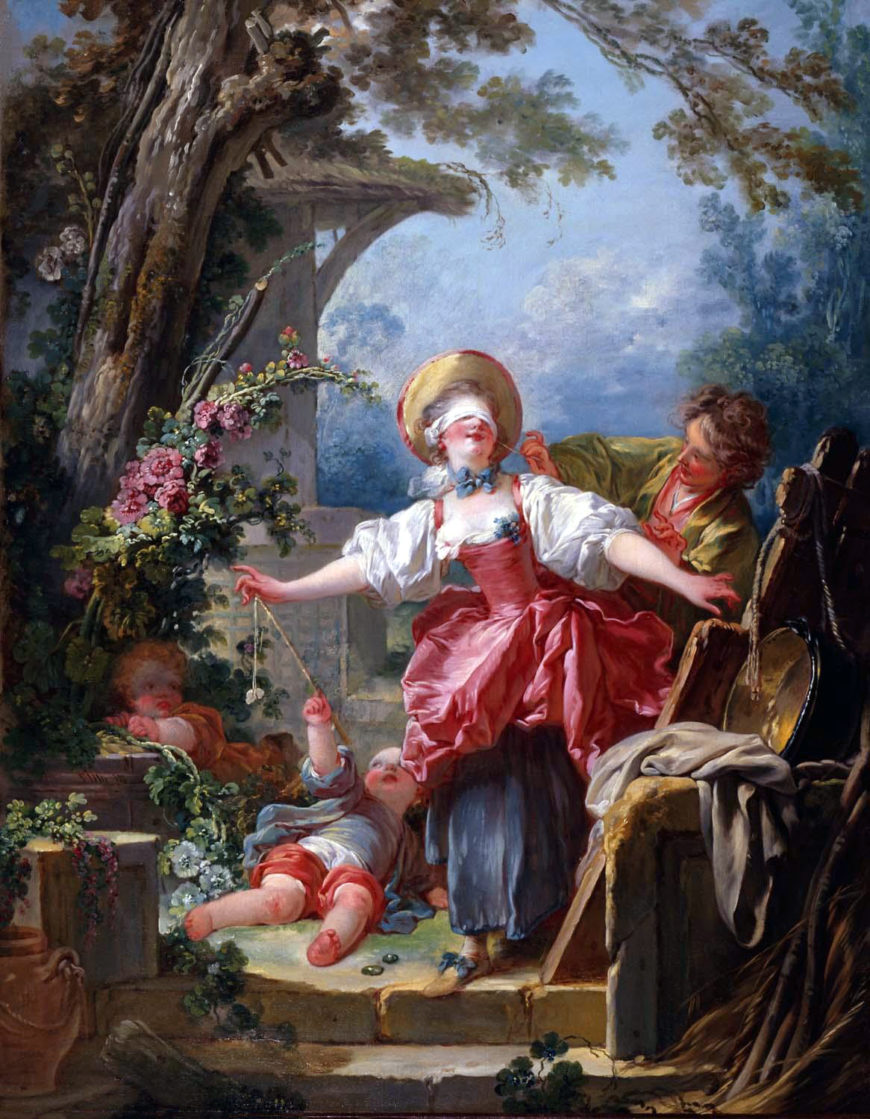
Jean-Honoré Fragonard, Blind-Homo's Buff , 1750-52, oil on canvas, 46 ten 36 inches ( Toledo Museum of Art )
Swinging was one of several outdoor leisure activities common amidst elites in eighteenth-century France. Artists captured these popular games and pastimes in numerous works of art created for private patrons, such as 2 of Fragonard's earlier paintings: Blind Human's Bluff and The Encounter-Saw . The See-Saw's portrayal of a young woman gleefully raising her arms and legs as she is suspended in mid-air is a clear precedent for the pose of the main figure in The Swing . Both women recline back equally they lift their artillery about above their heads and kicking i leg up, revealing the expanse beneath their skirts. Eighteenth-century audiences would have considered this uninhibited behavior quite indecent nether ordinary circumstances. Withal, within the context of leisure activities, the flow'south established rules of social etiquette were oft bent.
Intimate garden-parks like the one depicted in The Swing were common sites for aloof leisure. These outdoor spaces were viewed every bit less formal than domestic interiors. Situated on the grounds of private country estates and pleasure pavilions, garden-parks provided a retreat from the strict regulations of elite lodge. Hither, French nobles could way themselves as carefree shepherds or milkmaids, a function-playing game alluded to by the swinging woman'due south straw lid. In addition, the hidden alcoves and underground corners inside these asymmetrical gardens enabled men and women to mingle more freely and couples to sneak abroad unchaperoned. Past juxtaposing various natural and man-made elements, Fragonard emphasizes the freedoms and restrictions French elites simultaneously experienced when playing in these spaces. While the fountains and trelliswork on the right advise efforts to manipulate nature, the overgrown plants and abandoned rake in the foreground underline that the will of nature—like that of honey—can never be fully constrained.
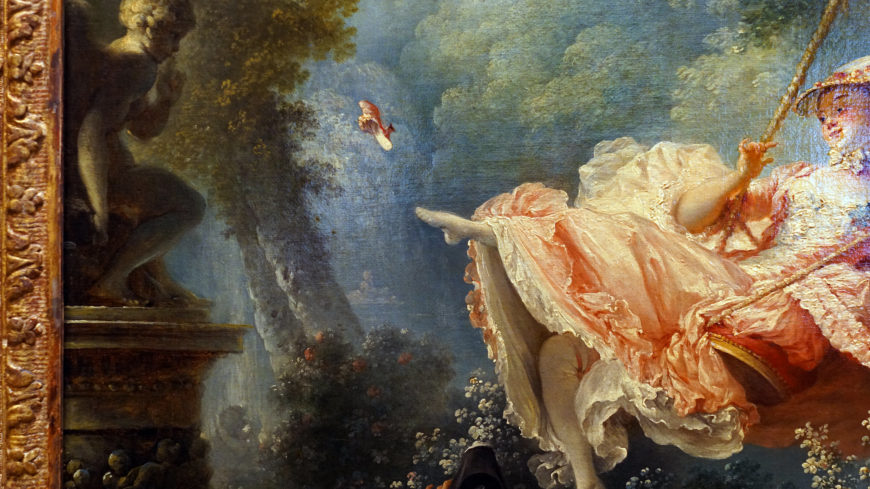
Female person effigy (detail), Jean-Honoré Fragonard, The Swing, 1767, oil on sheet, 81 x 64.2 cm (Wallace Collection, London; photograph: Steven Zucker, CC By-NC-SA 2.0)
Eroticism
The left side of The Swing includes multiple references to untamed desire. Clearest among these is the swinging adult female's raised left leg, which lifts the hem of her skirt to reveal her curved right calf clad with a white stocking and pink garter. This flirtatious human activity signals her rejection of the traditional constraints of female modesty.
The heeled slipper that flies off her pointed foot leads our eyes to a marble statue of Cupid (the mythological god of erotic love) on the far left. Fragonard based this object on a well-known sculpture created past Etienne-Maurice Falconet in 1755 for King Louis Fifteen's former mistress, Madame de Pompadour. Both the painted and sculpted Cupid bring the alphabetize finger of ane hand to their lips as they accomplish with the opposite paw to remove an arrow from their quivers. By showing the god facing the swinging woman every bit he makes this silencing gesture, Fragonard positions the two equally confidants sharing a secret.
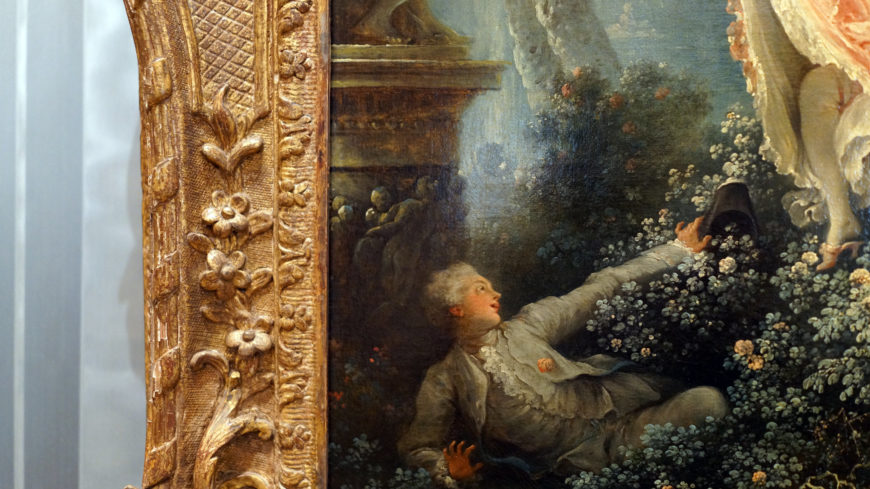
Young man leaning against the statue's pedestal (detail), Jean-Honoré Fragonard, The Swing, 1767, oil on sheet, 81 x 64.two cm (Wallace Collection, London; photo: Steven Zucker, CC BY-NC-SA 2.0)
The subject area of their charade is speedily discovered hiding in the rose bushes below. Here, a boyfriend leans against the statue's pedestal carved with images of dancing maenads . A seeming victim of the infatuation caused past Cupid'due south arrow, his broad-eyed gaze and extended left arm plough our attention to the exposed legs of the woman. The layers of her skirt open like the petals of the blooming pinkish roses on the bush below, a visual connectedness that suggests her fertility rivals that of the garden itself.
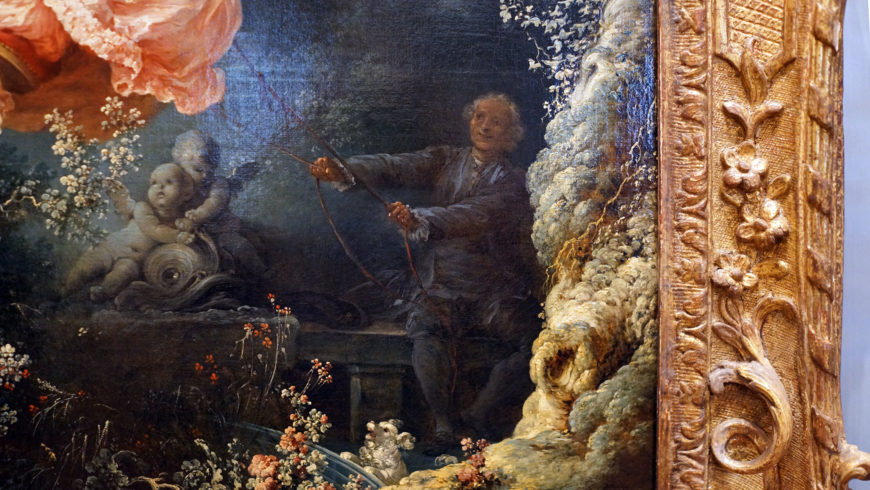
Older man (detail), Jean-Honoré Fragonard, The Swing, 1767, oil on canvas, 81 10 64.two cm (Wallace Collection, London; photo: Steven Zucker, CC Past-NC-SA two.0)
These references to unbridled passion are counterbalanced past symbols of constraint on the correct side of the composition. Beside the garden'southward trellis and fountain, the older human operating the swing is presumably the hubby of the young woman. His smiling expression every bit he gazes at his wife suggests that he is blissfully unaware of her subconscious lover. A series of looks and gestures connects the 3 figures, creating an inverted V-shape that visually reinforces their individual roles in this beloved triangle. The ropes the husband uses to pull his wife toward him resemble a set of reigns and are evocative of both the bonds of marriage and the restrictions placed on female person sexuality during the period. The act of taming is further recalled past an adjacent sculpture of two putti riding a dolphin. While the winged bodies of these figures echo that of Cupid on the far left, the putto gazing at the swinging adult female adopts a concerned rather than conspiratorial expression. Likewise, the yapping white dog (a common symbol of fidelity) at the husband's anxiety seems to sound the alarm on the woman's bawdy behavior. Contrasting with Cupid equally secret-keeper, the barking domestic dog threatens to expose the adultery of its mistress.
The Rococo's visual games
While works similar The Swing would be critiqued as symbols of the moral disuse of aristocratic civilization, they were immensely popular during the eighteenth century. The appeal of these objects oft categorized as Rococo art rested not only in their styles or subjects, which were uncommonly diverse, merely likewise in their ability to engross viewers in visual games that comment on the nature of both art and humanity. The Swing draws us in through a mixture of visual sense of humour, double entendre, and loaded symbols that reward close looking. Like the woman swinging back-and-along, our attention is swiftly fatigued between the many rich details sprinkled across the painted sail. As our optics motion from one element to the next, nosotros detect charged symbols like the abandoned rake or yapping dog and recognize familiar characters such as Cupid or the dancing maenads . We also uncover intriguing connections betwixt the swinging woman and Venus (a companion of Cupid), Madame de Pompadour (patron of Falconet's sculpture), or a blooming blossom (like the pinkish rose adorning her lover's jacket). These discoveries provide us with mental exhilaration meant to rival the physical thrill of riders on a swing. Like swingers flying through the air while tethered to a stable object, nosotros are simultaneously free and supported equally we explore the artist's carefully constructed sail.

Jean-Honoré Fragonard, The Swing, oil on sheet, 1767 (Wallace Collection, London) (photo: Steven Zucker, CC BY-NC-SA 2.0)
Additional resource:
Wallace Collection The Swing Object Page
Wallace Collection The Swing Video
Jennifer Milam, Fragonard'south Playful Paintings: Visual Games in Rococo Art (Manchester, UK: Manchester University Printing, 2006).
Vanessa Bezemer Sellers, "From Italian republic to France: Gardens in the Court of Louis XIV and Afterward" on Heilbrunn Timeline of Fine art History (New York: The Metropolitan Museum of Art, 2000).
Ally Sheriff, Fragonard: Fine art and Eroticism (Chicago: University of Chicago Printing, 1990).
Perrin Stein, "Jean Honoré Fragonard (1732–1806)" on Heilbrunn Timeline of Art History (New York: The Metropolitan Museum of Art, 2000).
Smarthistory images for didactics and learning:
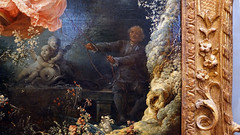


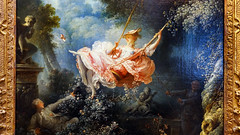

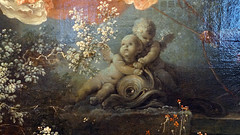
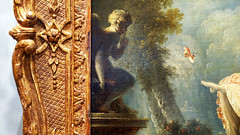
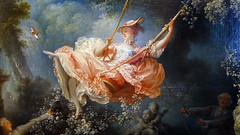
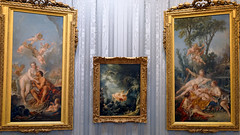
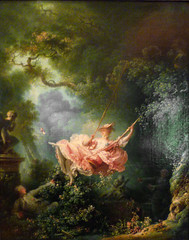
More Smarthistory images…
Source: https://smarthistory.org/jean-honore-fragonard-the-swing/
0 Response to "Sheriff Mary D Fragonard Art and Eroticism Diana Endymion"
Post a Comment